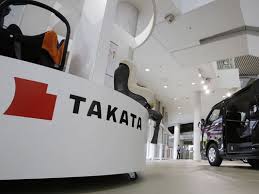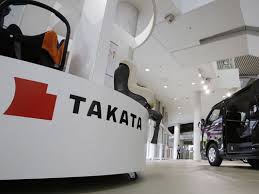
The Japanese auto supplier has insisted that the propellant in its airbags is safe as the safety crisis surrounding Takata’s airbags that are prone to rupture has mushroomed.
However as long as 16 years ago Takata’s own engineers discarded evidence that may have shown otherwise, testimony in a Florida court showed on Friday. Failures occurred during internal testing as early as 2000 when the propellant which includes a compound called ammonium nitrate was introduced into Takata models.
A senior Takata executive ordered some of the evidence be discarded as the company altered its test data to hide the failures from its biggest customer, Honda, the testimony said.
As part of a lawsuit brought by a Florida woman who was paralyzed after her Takata airbag deployed too forcefully during an accident in her 2001 Honda Civic in June 2014, Thomas Sheridan, a former Takata airbag engineer, was questioned this year. During a hearing over what evidence should be allowed at trial, her lawyers disclosed the testimony on Friday.
He had tried to examine airbag parts that had failed a series of performance tests included in a June 2000 report to Honda Motor, Mr. Sheridan said in his deposition.
Under orders from Takata’s vice president for engineering at the time, Al Bernat, he had found the parts had been discarded, he said. Former Takata test engineers have said that evidence was also discarded in a series of airbag tests in 2004 and Bernat has also been tied to the tests.
“I had the data but I wanted to go look for those parts. But when I went to look for the parts, because some of the parts had come apart, they were no longer available. They had been discarded,” Sheridan was quoted as saying in the deposition.
While a request for an interview with Mr. Bernat was turned down by Takata, a company spokesman said it “believes that the lawsuit is without merit and intends to defend itself vigorously.”
According to court documents, Takata did not report the failures to Honda but instead hid results by manipulating data that showed the propellant could combust violently, causing its casing — called an inflater — to overpressurize and rupture, according to the documents. The documents said that in several instances, “pressure vessel failures,” or airbag ruptures, were reported to Honda as normal airbag deployments.
“I think this was a complete breakdown of the entire organization to provide a safe product,” Sheridan said in his deposition.
He responded no when asked whether he was surprised that Takata airbags had since been linked to deaths and injuries.
“I didn’t think it would take so long for the failures to show up. It took a lot longer than I thought,” he said.
Takata’s airbag inflaters have been linked to 10 deaths, including one last month, and over 100 injuries as the airbags can overpressurize and explode when they deploy, shooting metal shards at passengers.
As many as 45 million metal inflators have been sold by Takata in the US. 14 automakers have recalled about 28 million inflaters in 24 million vehicles across the nation so far.
(Source:www.nytimes.com)
However as long as 16 years ago Takata’s own engineers discarded evidence that may have shown otherwise, testimony in a Florida court showed on Friday. Failures occurred during internal testing as early as 2000 when the propellant which includes a compound called ammonium nitrate was introduced into Takata models.
A senior Takata executive ordered some of the evidence be discarded as the company altered its test data to hide the failures from its biggest customer, Honda, the testimony said.
As part of a lawsuit brought by a Florida woman who was paralyzed after her Takata airbag deployed too forcefully during an accident in her 2001 Honda Civic in June 2014, Thomas Sheridan, a former Takata airbag engineer, was questioned this year. During a hearing over what evidence should be allowed at trial, her lawyers disclosed the testimony on Friday.
He had tried to examine airbag parts that had failed a series of performance tests included in a June 2000 report to Honda Motor, Mr. Sheridan said in his deposition.
Under orders from Takata’s vice president for engineering at the time, Al Bernat, he had found the parts had been discarded, he said. Former Takata test engineers have said that evidence was also discarded in a series of airbag tests in 2004 and Bernat has also been tied to the tests.
“I had the data but I wanted to go look for those parts. But when I went to look for the parts, because some of the parts had come apart, they were no longer available. They had been discarded,” Sheridan was quoted as saying in the deposition.
While a request for an interview with Mr. Bernat was turned down by Takata, a company spokesman said it “believes that the lawsuit is without merit and intends to defend itself vigorously.”
According to court documents, Takata did not report the failures to Honda but instead hid results by manipulating data that showed the propellant could combust violently, causing its casing — called an inflater — to overpressurize and rupture, according to the documents. The documents said that in several instances, “pressure vessel failures,” or airbag ruptures, were reported to Honda as normal airbag deployments.
“I think this was a complete breakdown of the entire organization to provide a safe product,” Sheridan said in his deposition.
He responded no when asked whether he was surprised that Takata airbags had since been linked to deaths and injuries.
“I didn’t think it would take so long for the failures to show up. It took a lot longer than I thought,” he said.
Takata’s airbag inflaters have been linked to 10 deaths, including one last month, and over 100 injuries as the airbags can overpressurize and explode when they deploy, shooting metal shards at passengers.
As many as 45 million metal inflators have been sold by Takata in the US. 14 automakers have recalled about 28 million inflaters in 24 million vehicles across the nation so far.
(Source:www.nytimes.com)





